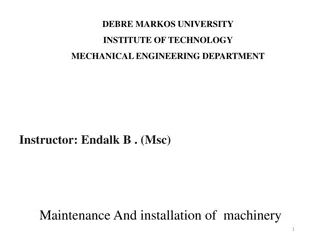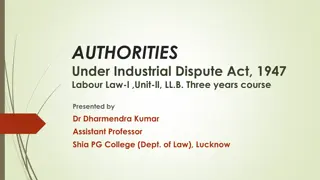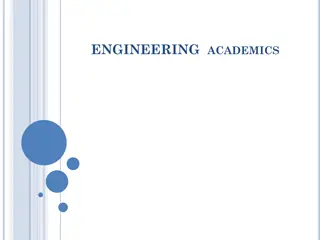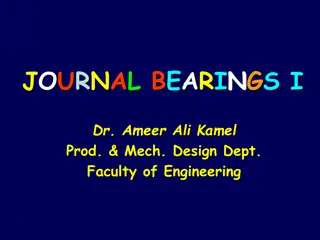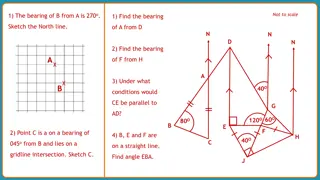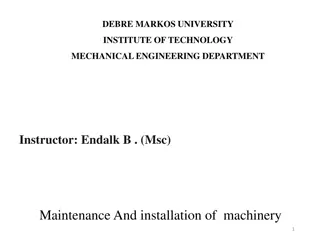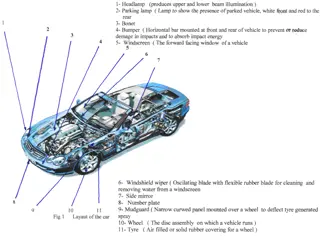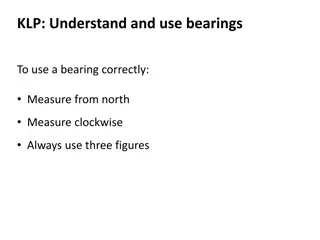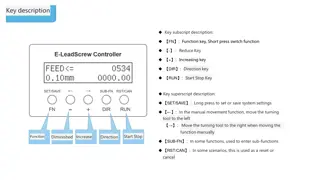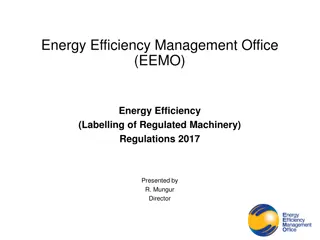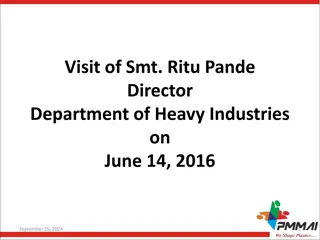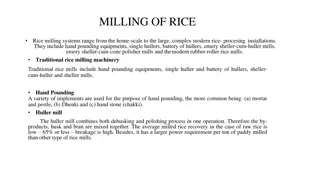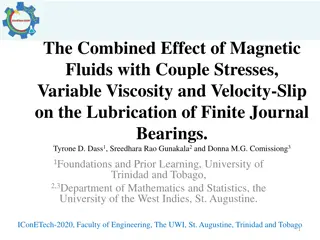Understanding Bearings in Machinery: Types and Applications
Bearings are crucial machine elements that support moving parts, allowing relative motion while carrying loads. They help reduce friction, wear, and heat generation by using lubricants. This content explains the classification of bearings based on load direction and nature of contact, covering radial bearings, thrust bearings, sliding contact bearings, and rolling contact bearings. Different types of sliding contact bearings like slipper bearings and journal bearings are also discussed, highlighting their applications in various industries.
Download Presentation

Please find below an Image/Link to download the presentation.
The content on the website is provided AS IS for your information and personal use only. It may not be sold, licensed, or shared on other websites without obtaining consent from the author. Download presentation by click this link. If you encounter any issues during the download, it is possible that the publisher has removed the file from their server.
E N D
Presentation Transcript
Introduction A bearing is a machine element which support another moving machine element (known as journal). It permits a relative motion between the contact surfaces of the members, while carrying the load. A little consideration shows that due to the relative motion between the contact surfaces, a certain amount of power is wasted in overcoming frictional resistance and if the rubbing surfaces are in direct contact, there will be rapid wear. In order to reducefrictional resistance and wear and in some cases to carry away the heat generated, a layer of fluid (known as lubricant) may be provided. The lubricant used to separate the journal and bearing is usually a mineral oil refined from petroleum, but vegetable oils, silicon oils, greases etc., may be used. 2
Classification of Bearings Depending upon the direction of load to be supported: (a) Radial bearings, and (b) Thrust bearings. In radial bearings, the load acts perpendicular to the direction of motion of the moving element. In thrust bearings, the load acts along the axis of rotation. These bearings may move in either of the directions as shown in figures (a), (b) and (c). 3
Depending upon the nature of contact. (a) Sliding contact bearings, and (b) Rolling contact bearings. In sliding contact bearings, the sliding takes place along the surfaces of contact between the moving element and the fixed element. They are also known as plain bearings. In rolling contact bearings, the steel balls or rollers, are interposed between the moving and fixed elements. The balls offer rolling friction at two points for each ball or roller. 5
Types of Sliding Contact Bearings The sliding contact bearings in which the sliding action is guided in a straight line and carrying radial loads, may be called slipper or guide bearings. The sliding contact bearings in which the sliding action is along the circumference of a circle or an arc of a circle and carrying radial loads are known as journal or sleeve bearings. When the angle of contact of the bearing with the journal is 360 , then the bearing is called a full journal bearing. This type of bearing is commonly used in industrial machinery to accommodate bearing loads in any radial direction. 7
When the angle of contact of the bearing with the journal is 120 , then the bearing is said to be partial journal bearing. This type of bearing has less friction than full journal bearing, but it can be used only where the load is always in one direction. The most common application of the partial journal bearings is found in rail road car axles. The full and partial journal bearings may be called as clearance bearings because the diameter of the journal is less than that of bearing. When a partial journal bearing has no clearance i.e. the diameters of the journal and bearing are equal, then the bearing is called a fitted bearing. 8
The sliding contact bearings, according to the thickness of layer of the lubricant between the bearing and the journal, may also be classified as follows : 1. Thick film bearings. The thick film bearings are those in which the working surfaces are completely separated from each other by the lubricant. Such type of bearings are also called as hydrodynamic lubricated bearings. 2. Thin film bearings. The thin film bearings are those in which, although lubricant is present, the working surfaces partially contact each other atleast part of the time. Such type of bearings are also called boundary lubricated bearings. 3. Zero film bearings. The zero film bearings are those which operate without any lubricant present. 4. Hydrostatic or externally pressurized lubricated bearings. Supports steady loads without any relative motion between the journal and the bearing. This is achieved by forcing externally pressurized lubricant between the members. 9
Assumptions in Hydrodynamic Lubricated Bearings The lubricant obeys Newton's law of viscous flow. The pressure is assumed to be constant throughout the film thickness. The lubricant is assumed to be incompressible. The viscosity is assumed to be constant throughout the film. The flow is one dimensional, i.e. the side leakage is neglected. 10
Important Factors for the Formation of Thick Oil Film in Hydrodynamic Lubricated Bearings A continuous supply of oil. A relative motion between the two surfaces in a direction approximately tangential to the surfaces. The ability of one of the surfaces to take up a small inclination to the other surface in the direction of the relative motion. The line of action of resultant oil pressure must coincide with the line of action of the external load between the surfaces. 11
Properties of Sliding Contact Bearing Materials Compressive strength. Bearing material should have high compressive strength. Fatigue strength. Bearing material should have sufficient fatigue strength withstand repeated loads. Comformability. It is the ability of the bearing material to accommodate shaft deflections and bearing inaccuracies by plastic deformation (or creep) without excessive wear and heating. Embeddability. It is the ability of bearing material to accommodate small particles of dust, grit etc., without scoring the material of the journal. Bondability. Many high capacity bearings are made by bonding one or more thin layers of a bearing material to a high strength steel shell. Thus, the strength of the bond i.e. bondability is an important consideration in selecting bearing material. 12
Corrosion resistance. This property is of particular importance in internal combustion engines where the same oil is used to lubricate the cylinder walls and bearings. In the cylinder, the lubricating oil comes into contact with hot cylinder walls and may oxidize and collect carbon deposits from the walls. Thermal conductivity. The bearing material should be of high thermal conductivity so as to permit the rapid removal of the heat generated by friction. Thermal expansion. The bearing material should be of low coefficient of thermal expansion, so that when the bearing operates over a wide range of temperature, there is no undue change in the clearance. 13
Materials used for Sliding Contact Bearings Babbit metal (Tin base babbits and Lead base babbits) Bronzes (gun metal and phosphor bronze) Cast iron Silver Non-metallic bearings (carbon-graphite bearings, soft rubber bearings,wood bearings, Nylon and Teflonbearings) 14
Nylon as a wear surface or liner for journal and other sliding bearings because of the following properties: It has lower coefficient of friction It can be used at higher temperatures up to about 315 C It is dimensionally stable because it does not absorb moisture It is practically chemically inert. 15
Lubricants The lubricants are used in bearings to reduce friction between the rubbing surfaces and to carry away the heat generated by friction. It also protects the bearing against corrosion. All lubricants are classified into the following three groups : 1. Liquid, 2. Semi-liquid, and 3. Solid 16
Liquid lubricants used in bearings are mineral oils and synthetic oils. The mineral oils are used because of their cheapness and stability. The liquid lubricants are preferred where they can be retained. Grease is a semi-liquid lubricant having higher viscosity than oils. Greases are employed where slow speed and heavy pressure exist and where oil drip from the bearing is undesirable. Solid lubricants are used where oil films cannot be maintained because of pressures or temperature. They should be softer than materials being lubricated. A graphite is the most common of the solid lubricants alone or mixed with oil or grease. 17
Properties of Lubricants Viscosity. It is a physical property by virtue of which an oil is able to form, retain and offer resistance to shearing a buffer film under heat and pressure. The greater the heat and pressure, the greater viscosity is required of a lubricant to prevent thinning and squeezing out of the film. Oiliness. It is a measure of the lubricating qualities under boundary conditions where base metal to metal is prevented only by absorbed film. Density. Useful in changing the kinematic viscosity to absolute viscosity. Viscosity index. The term viscosity index is used to denote the degree of variation of viscosity with temperature. 18
Flash point. It is the lowest temperature at which an oil gives off sufficient vapour to support a momentary flash. Fire point. It is the temperature at which an oil gives off sufficient vapour to burn it continuously when ignited. Pour point or freezing point. It is the temperature at which oil will cease to flow when cooled. 19
Diametral clearance. It the difference between the diameters of the bearing and the journal. c = D d . Radial clearance. It is the difference between the radii of the bearing and the journal. Mathematically, radial clearance, Diametral clearance ratio. It is the ratio of the diametral clearance to the diameter of the journal. 21
Eccentricity. It is the radial distance between the centre (O) of the bearing and the displaced centre (O ) of the bearing under load. It is denoted by e. Minimum oil film thickness. It is the minimum distance between the bearing and the journal, under complete lubrication condition. It is denoted by h0. Its value may be assumed as c/4. Attitude or eccentricity ratio. It is the ratio of the eccentricity to the radial clearance. 22
Short and long bearing. If the ratio of the length to the diameter of the journal (i.e. l/d) is less than 1, then the bearing is said to be short bearing. On the other hand, if l/d is greater than 1, then the bearing is known as long bearing. Note: When the length of the journal (l) is equal to the diameter of the journal (d), then the bearing is called square bearing. 23
Bearing Characteristic Number and Bearing Modulus for Journal Bearings The coefficient of friction in design of bearings is of great importance, because it affords a means for determining the loss of power due to bearing friction. It has been shown by experiments that the coefficient of friction for a full lubricated journal bearing is a function of three variables, i.e. 24
The factor ZN/pis termed as bearing characteristic number and is a dimensionless number. 25
Minimum amount of friction occurs at Aand at this point the value ofZN/p is known as bearing modulus which is denoted by K. The bearing should not be operated at this value, because decrease in speed or increase in pressure will break the oil film and make the journal to operate with metal to metal contact. 26
Critical Pressure of the Journal Bearing The pressure at which the oil film breaks down so that metal to metal contact begins, is known as critical pressure or the minimum operating pressure of the bearing. It may be obtained by the following empirical relation, 28
Sommerfeld Number The Sommerfeld number is also a dimensionless parameter used extensively in the design of journal bearings. 29
Heat Generated in a Journal Bearing The heat generated in a bearing is due to the fluid friction and friction of the parts having relative motion. 30
The mass of the oil to remove the heat generated at the bearing may be obtained by equating the heat generated to the heat taken away by the oil. 31
Solid Journal Bearing A solid bearing is the simplest form of journal bearing. It is simply a block of cast iron with a hole for a shaft providing running fit. The lower portion of the block is extended to form a base plate with two holes to receive bolts for fastening it to the frame. An oil hole is drilled at the top for lubrication. The main disadvantages of this bearing are: 1. There is no provision for adjustment in case of wear, 2. The shaft must be passed into the bearing axially. This type of bearing is used when the shaft speed is not very high and the shaft carries light loads. 32
Bushed Bearing A bushed bearing is an improved solid bearing in which a bush of brass or gun metal is provided. The outside of the bush is a driving fit in the hole of the casting whereas the inside is a running fit for the shaft. When the bush gets worn out, it can be easily replaced. In small bearings, the frictional force itself holds the bush in position, but for shafts transmitting high power, grub screws are used for the prevention of rotation and sliding of the bush. 34
Split Bearing or Plummer Block A split-bearing is used for shafts running at high speeds and carrying heavy loads. A split bearing consists of a cast iron base, gunmetal or phosphor bronze brasses, bushes or steps made in two-halves and a cast iron cap. The two halves of the brasses are held together by a cap or cover by means of steel bolts and nuts. 35
Oil Groves The oil grooves are cut into the plain bearing surfaces to assist in the distribution of the oil between the rubbing surfaces. It prevents squeezing of the oil film from heavily loaded low speed journals and bearings. The tendency to squeeze out oil is greater in low speed than in high speed bearings, because the oil has greater wedging action at high speeds. 36
Thrust Bearings A thrust bearing is used to guide or support the shaft which is subjected to a load along the axis of the shaft. Such type of bearings are used in turbines and propeller shafts. The thrust bearings are of the following two types : 1. Foot step/pivot bearings 2. Collar bearings In a foot step or pivot bearing, the loaded shaft is vertical and the end of the shaft rests within the bearing. In case of collar bearing, the shaft continues through the bearing (e.g. Center bearing of propeller shaft). 37
In design, it is assumed that the pressure is uniformly distributed throughout the bearing surface. Let 39
When the pressure is uniformly distributed over the bearing surface, then bearing pressure, 42
Reference: A text book of machine Design by Khumi & Gupta Web: www.lunyax.wordpress.com Email: Jonathan.lunyungu@outlook.com 44




